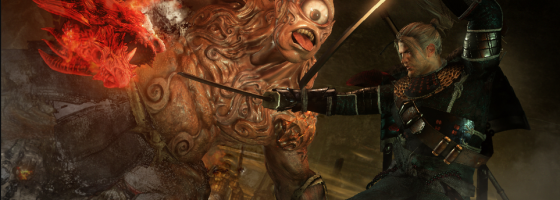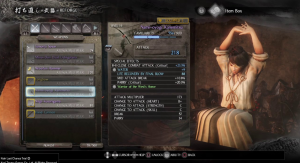It’s been awhile since Team Ninja has been in the action game spotlight. After the amazing Ninja Gaiden series, the company disappeared into the background following Itagaki’s departure. Working in partnership with other developers since then, Nioh is their first in-house developed game in some time. With Nioh, we have a return to form from the company and perhaps the next serious contender to the Soulsborne throne.
Ancient History:
The story of Nioh takes places during the Sengoku period of Japan. You play as a fictionalized take on William Adams; the man who became the first Western Samurai. Following Great Britain defeating the Spanish armada, it was discovered that they used a magical power called Amrita to secure the victory.
William finds himself about to be executed when a magical ally, a guardian spirit, comes to aid him. From there, his journey will take him back to the Far East to fight someone who intends to use the Amrita for nefarious purposes.
Unlike recent entries in the Souls series, Nioh is set up in a mission format. Within each mission, you’ll fight a variety of enemies; many of which are based on Japanese folklore. While Nioh may look familiar to action and Souls fans, there are a number of differences to talk about.
Ki Pacing:
Nioh’s combat pacing has a different feel to it compared to other action games. From the outside, it may look like Ninja Gaiden mixed with Dark souls, but that’s not the case. As a point of comparison, I found it to be faster than Bloodborne, but slower than Ninja Gaiden.
Nioh’s combat is built around different classes of weapons; each with a perk tree and style of fighting. Every weapon can be handled in one of three stances: High, Middle and Low. The stances determine how you swing the weapon, the damage output, and more importantly, the Ki usage.
Ki in Nioh is the equivalent of stamina in the Souls series. Attacking, taking damage, and blocking will consume Ki. Unlike the Souls games, running out of Ki comes at a great price. If your guard gets broken while out of Ki, you will be unable to move and can be critically hit.
What keeps this from becoming imbalanced is the fact that every character, including bosses, uses Ki.
Combat becomes a balance of managing Ki while trying to get your opponent to run out. Monster-type enemies or Yokai will only lose Ki when they’re damaged.
Besides Ki, you also have the ability to summon a “living weapon” out of selectable guardian spirits. While using a living weapon, you are immune to damage, but hits will lower your time with the weapon. Supplementing your weapons are magic and ninja arts that you can equip. They can provide everything from throwable weapons to passive buffs and more.
So far Nioh sounds a lot like soulsborne, but what it does with its weapons is something entirely different.
The Perfect Weapon:
While it may not look it, Nioh has strong ties to the ARPG genre. Every piece of gear in the game is procedurally generated based on rarity and type. The higher the quality will determine the number of special effects that it will have and how far it can be boosted by using it. There are also set items that can be equipped for additional bonuses.
The beauty of this system is that Nioh provides you with ways of preserving gear that you like, or getting something better. The blacksmith allows you to combine gear to raise the level of gear that you want to keep using. You can also re-roll special effects to try and get your dream combination going. For more on this, you can watch my guide on using the blacksmith:
On one hand, this does limit the uniqueness of the weapons compared to Bloodborne, but it provides another layer of customization for the player.
Nioh is all around a great game, and my main problems are more about the fine details.
The Yokai in the Details:
Nioh exists in a strange position compared to recent action games. On one hand, the game wants to be about the methodological pacing and positioning of Dark Souls. On the other hand, it also is about high speed combat similar to Ninja Gaiden.
When the two come together, it doesn’t perfectly mesh in my opinion. During combat, there is a noticeable delay when performing commands of different buttons one after the other. I noticed this when trying to switch from light and heavy attacks, dash to block and so on. That split second of delay has caused an untold number of deaths for me.
Another issue has to do with fighting humanoid enemies. Depending on your weapon and the skills equipped, certain enemies can be a lot more frustrating to fight. You’ll find that blocking enemies have enough Ki for the most part to just wait you out while you run out of Ki. I would have liked a little more technical gameplay in terms of basic moves to use.
Once you settle on a weapon that you like, you’ll be making use of the same combos over and over again. Speaking of weapons, the blacksmith system may lead to some polarizing opinions.
Luck of the Loot:
Nioh loot system was an interesting design decision to include in a game like this. The issue is that for a game that is so skill dependent, the luck of loot drops is a big deal. Getting the right items and special effects can really impact your way through. Once you start equipping exotic (purple) gear, the rest of the gear loses almost all utility.
The special effects range from completely useless to game-breakingly powerful. One of my weapons is my go-to boss killer with all rare and exotic modifiers. I also wish that it was easier to sort through all the items that you pick up. You can tell the game to select gear of certain varieties, but not of certain levels.
There’s an additional mechanic of being able to transfer select skills through soul match, but I found that it wasn’t worth the additional time.
A Cut above the Rest:
Nioh is an amazing game and a return to form for Team Ninja. The problems I have with the game could easily be fixed through refinement if it turns into a series. If you don’t mind some loot hunting, Nioh is a great action game.
For more on it, you can watch my let’s break going through all the main missions:




